Gravelbar32
Full Member
For those interested, see my original post, "This Is so cool", about finding this NA site on my property. After finding the horde of knives last night, I just had to skip work and go back this morning. I burned leaves and picked up surface rocks below the bluff the final 5 feet up to the bluff where I found the first knife laying on a ledge in the open. It was a constant stream of large flake knives and burned stone apexing right up to the bluff of limestone. The central part of the fire was literally up against the stone bluff where I did see some reddening of the limestone in the bluff itself. At the apex of the debris field I found a dozen smaller knives and a few pieces of bone in the charcoal. Here is part of this mornings haul.
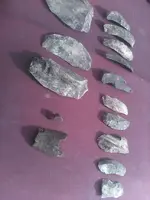 The bone is in the lower left.
The bone is in the lower left.
Just crazy. So many knives and not a flake or chip as a sign of tool making. No pottery. No points. No scrapers. No drills. Nothing that would indicate everyday life. Absolutely nothing four feet up on top of the bluff where you could see for miles. Originally I thought it was an isolated camp in bad weather but too many knives and a big fire. Then I thought a butchering and drying site, still too many knives. Knife processing site? Maybe? I dunno. But I sure had fun picking thru it with more to go. I so wanted to find a point or celt or grooved axe, but no. Just giant flakes!
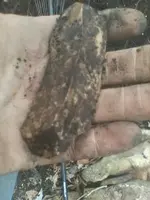
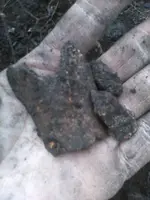 Bone
Bone
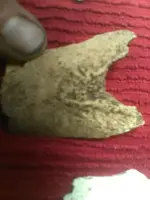 Bone
Bone
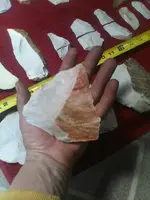
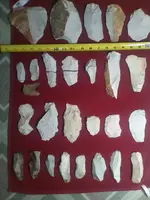 Most of the whole pieces. Not fancy, but fascinating. Most from an area the size of your utility room!
Most of the whole pieces. Not fancy, but fascinating. Most from an area the size of your utility room!
 The bone is in the lower left.
The bone is in the lower left.Just crazy. So many knives and not a flake or chip as a sign of tool making. No pottery. No points. No scrapers. No drills. Nothing that would indicate everyday life. Absolutely nothing four feet up on top of the bluff where you could see for miles. Originally I thought it was an isolated camp in bad weather but too many knives and a big fire. Then I thought a butchering and drying site, still too many knives. Knife processing site? Maybe? I dunno. But I sure had fun picking thru it with more to go. I so wanted to find a point or celt or grooved axe, but no. Just giant flakes!

 Bone
Bone Bone
Bone
 Most of the whole pieces. Not fancy, but fascinating. Most from an area the size of your utility room!
Most of the whole pieces. Not fancy, but fascinating. Most from an area the size of your utility room!Amazon Forum Fav 👍
Upvote
0





